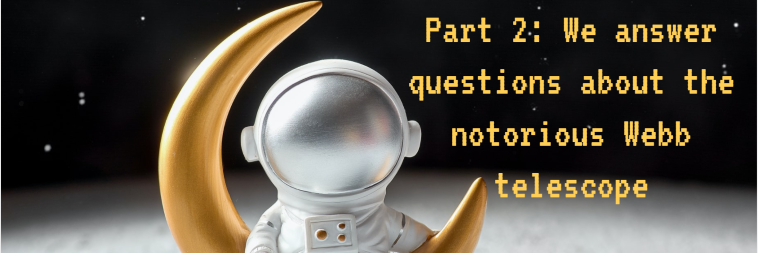Part 2: We answer questions about the notorious Webb telescope

In this blog, we will answer some of the most interesting questions regarding the famous JWST. Care to upgrade your knowledge a little?
Why are the mirrors golden?
Well, because they have a thin layer of gold on the outer surface.
18 hexagonal segments of the primary mirror – along with secondary and tertiary mirrors – are made of beryllium, a metal chosen for its lightness, robustness, and ability to withstand the very low temperatures to which telescopic optics are exposed.
However, beryllium does not reflect very well in the infrared spectrum, so a layer of gold only 120 nanometers thick was applied to improve the reflective properties.
Barely 3 grams of gold were used to cover each hexagonal segment.
Okay, okay, but why gold? Why is aluminum or some other material that is typically used in traditional mirrors not used in this instance as well? The reason is that aluminum reflects the infrared radiation poorly, while the reflection reaches 98% with gold.
In fact, even in the visible spectrum, aluminum doesn’t work that great, but it is much cheaper and easier to use.
Of course, the use of gold makes ‘James Webb’ capable of observing only wavelengths greater than 0.6 microns, a figure that dictated instrument design and scientific goals.
Why will it be located at point L2?
JWST will observe the sky from the Lagrange point L2 (ESML-2) of the Earth-Sun system, about 1.5 million kilometers from Earth. Although, technically, it will not be fixed at the ‘point’ but will describe the orbit around L2.
It seems that it is far away, but when the spacecraft is sent out of the Moon’s orbit, there is no big difference in terms of energy, whether it will be half a million or two million km.
The main advantage of L2 is that JWST will be far from the infrared radiation emitted by the Earth and the Moon.
If ‘James Webb’ were in a low orbit like ‘Hubble’, the heat emitted by our planet, even from the night hemisphere, would make it impossible for the telescope to be at -233ºC needed to be able to study the sky in the infrared spectrum.
Earth’s heat would literally blind the telescope’s instruments. This would be something like observing an object in the visible spectrum until it emits light.
Now, is it necessary to go that far? At point L2, the gravitational force created by the Earth is balanced with the force of the Sun, so that the spacecraft located at this point will have a relatively stable position in relation to the Earth.
This will allow the telescope to keep its optics away from the Sun while the other side is always facing the Earth.
These conditions are also met at point L1, but since it is in the direction of the Sun, it is interesting only if we wanted to observe Earth.
In a high orbit, such as a geostationary one, the Earth’s glow in infrared radiation would still be very intense and, although it seems counterintuitive, more energy (Delta-V) is needed to reach it.
What challenges will JWST face when placed in position?
Point L2 is not a cure-all. The James Webb telescope will produce 300 gigabits of data per day that must be transferred to Earth.
The ship’s computer has a memory of 471 gigabits. Data will be downloaded using NASA’s Deep Space Network (DSN) twice a day in four-hour sessions.
Remember that the farther the satellite is from the Earth, the more complex the communication system must be and the larger the antennas for receiving data on Earth.
In that sense, point L2 is worse than a geostationary orbit, but the advantages and disadvantages need to be balanced.
Another drawback is that the halo orbit around point L2 is not completely stable, so ‘James Webb’ will have to use fuel to maintain a correct orbit and to suppress the effects of radiation pressure from sunlight on the reaction point.
Due to this, the telescope carries 300 kg of hypergolic fuel.
In fact, fuel consumption will be the main limitation of the lifespan of ‘James Webb’, which is estimated at ten and a half years. The primary scientific mission will last five years).
For example, to avoid the use of fuel, the Spitzer Telescope was placed in a heliocentric orbit. This would be a good alternative to ‘James Webb’ in theory.
In reality, the downside is that the angle to the Sun and Earth is constantly changing, which, with the greater distance from our planet, makes it a little difficult to transfer huge amounts of data, generate and plan observations in advance.
Want to read more about the universe? Visit our blog!

